Ethan R. Brush
Energy, Environmental, Transportation |
Market Co-Leader
Principal
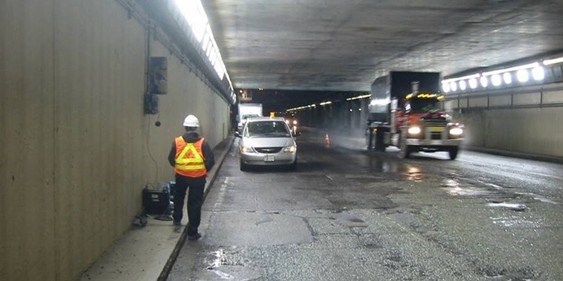
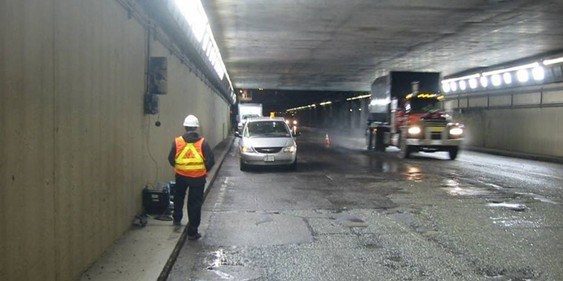
The following white paper was published in Sound and Vibration. To view the original PDF, click here.
Pressure and proximity measurements made in a tunnel indicate that a typical vehicle passage produced on the tunnel roof an initial pressure increase of small magnitude, followed by a sharp and more substantial drop in pressure below atmospheric. The magnitude of the pressure drop was found to increase with smaller clearances between the vehicle top and the tunnel roof, consistent with the Bernoulli relation and the vehicle speed. The dynamic pressures potentially may have significant effects on the vibration and noise environments on the lower floors of “air rights construction” buildings that span highways.
Keywords: Pressure pulses, vehicle passages, tunnel roofs.
It is well known that moving vehicles, such as automobiles and trucks, displace the ambient air and generate air flows and pressures around them. Thus, vehicles passing through tunnels are expected to produce pressure loads on the tunnel surfaces. Where highways are spanned by buildings (in so-called air rights construction) the pressure pulses from passing vehicles have the potential to generate undesirable vibrations and noise in these buildings, and in extreme cases to lead to structural integrity concerns. The pressure produced in tunnels by train passages have been studied extensively (1-3), but relatively little work appears to have been done on similar pressures induced by passages of road vehicles. Although the pressures produced by cars and trucks driving past panels with small areas-e.g. road signs and wall segments-have been investigated on the basis of scale-model studies and to a limited extent by means of full-scale measurements (4-5), no full-scale data pertaining to the corresponding pressures on tunnel roofs appear to be available. In order to quantify these dynamic pressures as series of measurements were made on the roof of a tunnel that carries a depressed major highway.
The present investigation was prompted by complaints about noise and vibration intrusions on the lowest levels of a large meeting and exhibit facility built in air-rights construction fashion atop a depressed major highway. (Commercial considerations dictate that this facility not be identified and that the intrusions not be discussed quantitatively.) These intrusions were ascribed to vehicle passages under the facility; they were observed to be most significant during periods of heavy traffic and to be most severe when vehicles passed directly below the locations of concern.
In order to investigate the dynamic pressures associated with vehicle passages a team of field engineers installed pressure sensors and proximity sensors on the underside of the tunnel roof, atop the midpoints of the highway’s marked traffic lanes. A video recorder was added to permit determination of the vehicle types. Acoustic sensors (microphones) also were put in place at these locations, but the recorded sound data are not relevant to the present discussion. The signals from all sensors were recorded for several hours and later analyzed in the laboratory.
Figure 1 shows a typical view inside the tunnel and gives an indication of the magnitudes of the clearances between the tunnel roof and the tops of vehicles.
Figure 1. View inside tunnel.
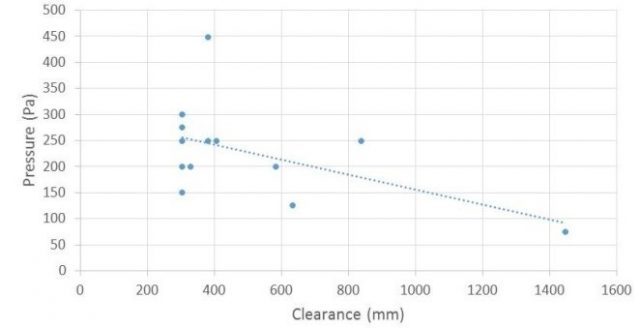
Representative data recordings obtained from the pressure and proximity sensors are shown in Appendix A, together with pictures of the relevant vehicles taken from the related video recordings. The data show that a vehicle passage typically resulted in a relatively small pressure increase (above atmospheric pressure) of somewhat extended duration, followed by a considerable decreased pressure (below atmospheric pressure) of short duration. The greatest deviations from atmospheric pressure were found to be negative; that is, below atmospheric. This behavior is similar to that reported in references4-5 and agrees with what one might expect: Initial compression of the air between the top of the passing vehicle and the tunnel roof, followed by flow of the air between these two surfaces and a corresponding pressure reduction due to the Bernoulli Effect.
Figure 2 summarizes the data obtained for all of the vehicle passages for which the aforementioned data were captured. It relates the greatest magnitude of the negative pressure measured during a vehicle passage to the minimum clearance between the vehicle top and the tunnel roof observed during that passage. Although the data show considerable scatter, there is a clear trend indicating greater negative pressures magnitudes are associated with smaller clearances.
Figure 2. Variation of magnitude of negative pressure with clearance.
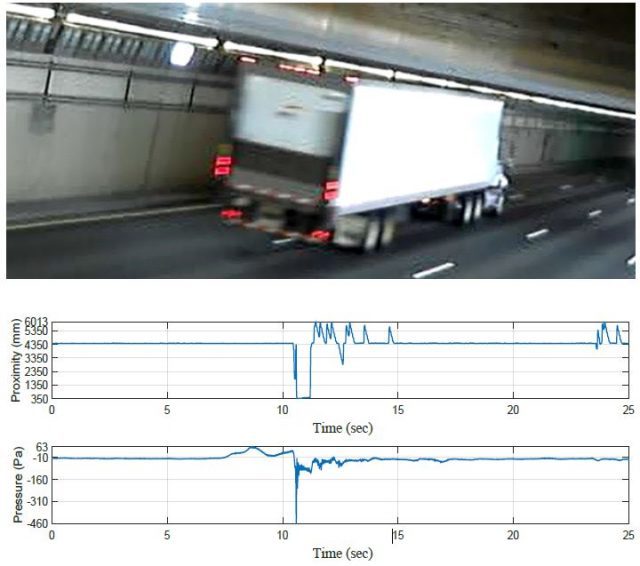
If one assumes that the ambient air has a density of 1.225 kg/m3 (0.0765 lb/ft3)-corresponding to sea level pressure and 15℃ (60 0F) temperature-one finds from the Bernoulli relation that a pressure decrease of 250 Pa (5 PSF) from atmospheric corresponds to an air flow velocity of about 71 kph (44 mph) that is uniform across the clearance space. Thus, the air flow velocity corresponding to the negative pressure observed in the relatively small clearance of 300 mm (12 in) is approximately equal to the typical vehicle speed in the tunnel. One may expect the air flow velocities in larger clearances to differ more from the vehicle speed than one would find from the Bernoulli relation because these velocities typically vary considerably across the flow area.
The dynamic pressures acting on the tunnel roof due to vehicle passages-particularly the negative pressures-often exceed 250 Pa (5 PSF). The sharp impulsive nature of these pressures implies that they may be expected to excite the tunnel roof (or air-rights floor) structures predominantly at frequencies above their fundamental natural frequencies, suggesting that reduction of these responses can be achieved best by adding mass and damping to these structures.
Since the observed pressures are capable of producing significant transient vibrations and attendant structurally radiated sound, both of which can contribute appreciably to discomfort and annoyance of people occupying the lowest levels of air- rights construction, vibration control design of these areas should take these contributions into account.
In view of the fact that negative pressures represent downward forces on the tunnel roof structure, these add loading on that structure in the same direction as the gravity loading and the dominant loading due to personnel activities. It appears advisable therefore that this added dynamic loading be taken into consideration in the structural design of air rights construction.
This appendix presents data obtained for representative vehicle passages. It consists of five figures, each comprised of a photograph of the passing vehicle and the related time traces obtained from the roof-mounted proximity and pressure sensors. The photographs were obtained from video recordings made by a camera located on the tunnel roof, adjacent to the aforementioned sensors.
Figure A1. Passage of eighteen-wheel semi.
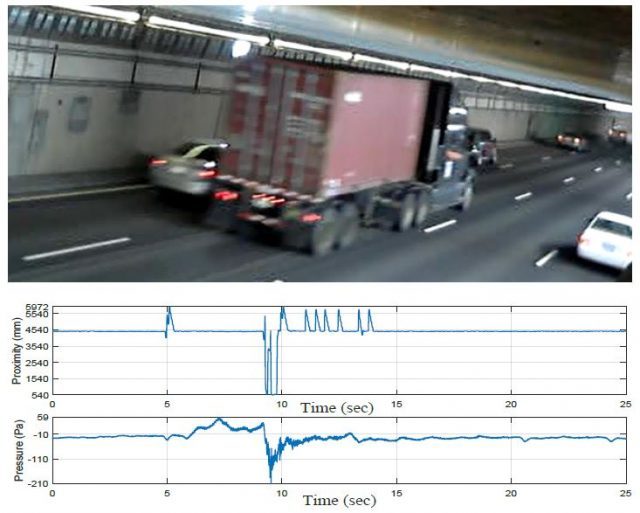
Figure A2. Passage of short trailer.
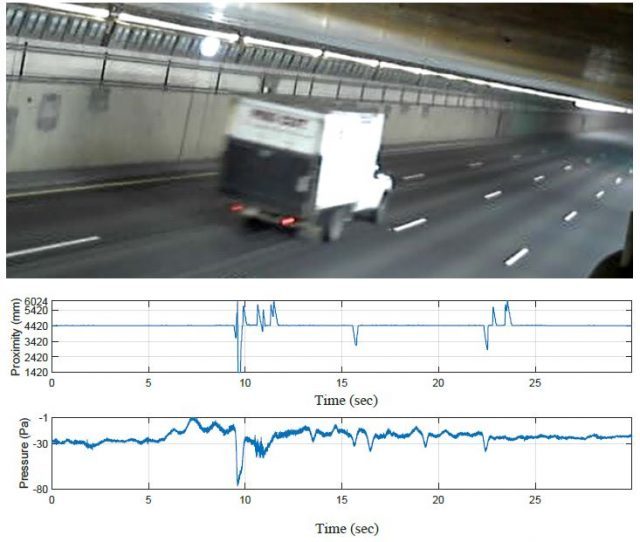
Figure A3. Passage of small box truck.
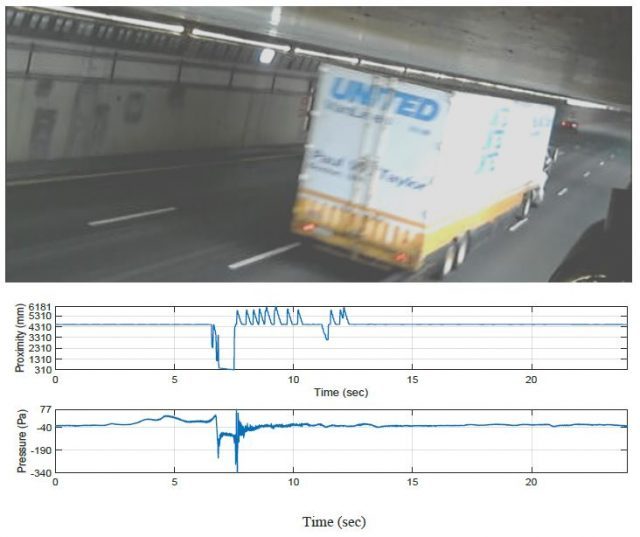
Figure A4. Passage of large truck.
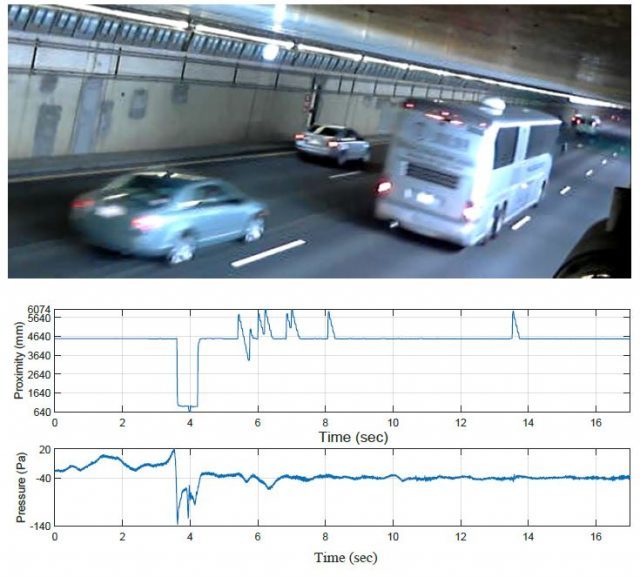
Figure A5. Passage of small bus.
References
The authors can be reached at: eungar@acentech.com
1. Chen, T. Y., Lee, Y. T. “Investigation of piston effect and jet fan effect in model vehicle tunnels.” Journal of Wind Engineering and Industrial Aerodynamics. Vol. 73, No. 2, pp. 99-110, 1998.
2. Palermo, N. M., Vardy, A. “Tunnel gradients and aural health for train passengers”, Proceedings of the Institution of Mechanical Engineers, Part F: Journal of Rail and Rapid Transit. Vol. 228, No. 7, pp. 821-832, 2014.
3. Yung, Y. K., Cheng, H. C., Ing, T. H., Shin, T. W. “Field measurements of aerodynamic pressures in tunnels induced by high speed trains”, Journal of Wind Engineering and Industrial Aerodynamics. Vol. 100, pp. 19-29, 2012.
4. Quinn, A. D., Backer, C. J., Wright, N. G. “Wind and vehicle induced forces on flat plates-Part 2 Vehicle induced forces” Journal of Wind Engineering and Industrial Aerodynamics, Vol. 88, pp. 831- 847, 2001.
5. Lichtneger, P., Ruck, B. “Transient wind loads on flat elements induced by passing vehicles” Fachtagung “Lasermethoden in der Schwingungstechnik” Proceedings of Technical Field Meeting “Laser methods in vibration engineering” , pp. 1-12, 2013.